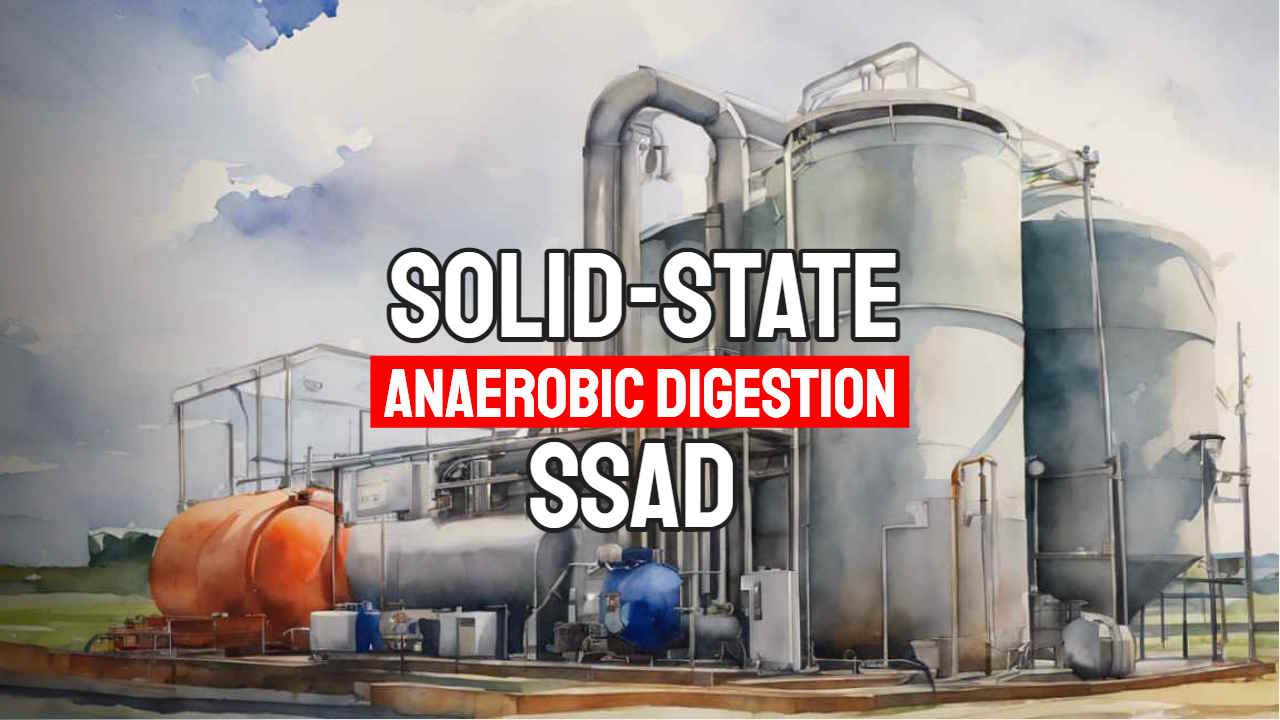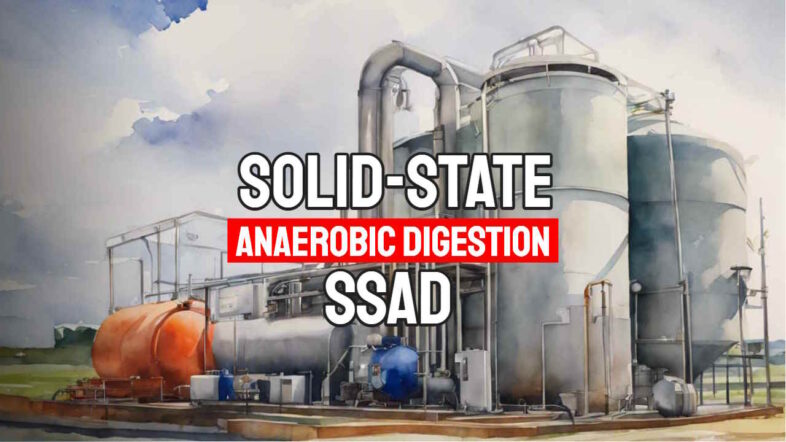Solid state anaerobic digestion (SSAD) is a type of anaerobic digestion (AD) process that takes place in the absence of free liquid.
What is Solid-State Anaerobic Digestion?
This type of anaerobic digestion is carried out using solid organic matter, such as manure fibre, some low moisture open structured food waste types, or poultry litter, as opposed to the liquid organic matter and slurries created with added water used in the Wet AD process and other types of anaerobic digestion.
The advantages of solid-state anaerobic digestion over other types of anaerobic digestion are that it can be carried out at a lower temperature, it is less sensitive to environmental fluctuations, and it may produce a higher quality of biogas.
The solid-state anaerobic digestion process generally begins with the spraying of the organic waste with water. The mixture is then heated to the optimal temperature for the microorganisms to break down the organic matter. The mixture is then allowed to cool, and the solid and liquid fractions are separated.
The solid fraction is composed of the undigested organic matter, which can be used as a fertilizer, and the microbial cells. The liquid fraction is composed of the biogas and water. The biogas can be used as a fuel, and the water can be reused in the process.
The solid-state anaerobic digestion process is a promising technology for the sustainable management of organic waste. It has the potential to reduce environmental pollution, generate renewable energy, and produce a high-quality fertilizer.

Advantages of Solid-State Anaerobic Digestion. vs Wet AD
Anaerobic digestion is a process that breaks down organic matter to produce biogas, which can be used as a renewable energy source. There are two types of anaerobic digestion: wet and solid-state. Each has its own advantages and disadvantages.
Wet anaerobic digestion (AD) involves mixing organic waste with water to create a slurry. This slurry is then fed into a digester, where microorganisms break down the organic matter to produce biogas. The advantage of wet AD is that it is less energy-intensive than solid-state AD. The disadvantage of wet AD is that it requires a large amount of water, which can be costly, and the slurry can be difficult to handle.
Solid-state anaerobic digestion (AD) involves mixing organic waste with an inert material, such as sand or straw. This mixture is then fed into a digester, where microorganisms break down the organic matter to produce biogas. The advantage of solid-state AD is that it requires less water than wet AD. The disadvantage of solid-state AD is that it is more energy-intensive than wet AD.
Challenges Faced During Solid-State Anaerobic Digestion
The process of solid-state anaerobic digestion (SS-AD) is a promising technology for the treatment of various types of wastes, including manure, food waste, and municipal solid waste. However, there are several challenges that need to be addressed in order to make this technology more viable and efficient.
One of the key challenges is the lack of knowledge and experience with SS-AD. This is a relatively new technology and there is still much to learn about the best practices for operating and managing SS-AD systems. There is also a need for more research to develop improved methods for pretreating SS-AD feedstocks and for monitoring and controlling the process.
Another challenge is the high cost of SS-AD systems. The upfront cost of constructing a SS-AD system can be several times higher than that of a conventional aerobic digestion system. This is partly due to the need for specialised equipment and materials, and also due to the fact that SS-AD systems are often built on a smaller scale than aerobic digestion systems.
Operational challenges can also be a barrier to the successful implementation of SS-AD. For example, SS-AD systems require careful control of temperature, pH, and moisture content to function optimally. This can be difficult to achieve, particularly in tropical and subtropical climates where temperature and humidity can fluctuate widely.
Despite these challenges, SS-AD has great potential as a tool for waste management and resource recovery. With further research and development, it is likely that many of the challenges currently associated with SS-AD will be overcome.

The Role of Fermentation in Solid-State Anaerobic Digestion
SSAD involves the fermentation of organic matter in the absence of free liquid, and results in the production of methane-rich biogas. The advantages of SSAD over other AD processes include the ability to treat a wider range of feedstocks, higher methane yields, and lower operating costs. The main disadvantages of SSAD are the longer start-up time and the higher capital costs.
The role of fermentation in SSAD is to provide the microorganisms with the necessary environment to break down the complex organic molecules into simpler compounds. The microorganisms involved in SSAD are typically methanogens, which are able to convert the complex organic molecules into methane and carbon dioxide.
The first step in SSAD is the hydrolysis of complex organic molecules into simpler sugars and amino acids. This step is typically carried out by enzymes secreted by bacteria. The second step is the fermentation of these sugars and amino acids by bacteria into methane and carbon dioxide.
Methane is the major component of biogas, and is a valuable energy source. The main uses of biogas are for electricity generation, 35% heat production, 26% transportation, 18% industrial applications, and 5% domestic uses. methane yields, and lower operating costs.
Solid-State Anaerobic Digestion of Municipal Solid Waste
Municipal solid waste (MSW) is a complex mixture of organic and inorganic materials that is generated daily from residential and commercial activities. This waste stream typically contains a large percentage of food waste, which can make up 50-80% of MSW by weight. Unfortunately, MSW also contains a variety of other materials that are not easily degraded, such as plastics, metals, and glass. As a result, MSW disposal has become a major environmental concern worldwide.
landfill space is becoming increasingly scarce and expensive, while public opposition to landfilling is growing. MSW incineration is an alternative waste disposal option, but it is often not economically viable and can release emissions that are harmful to air quality.
Solid-state anaerobic digestion (SS-AD) is a promising technology for the sustainable management of MSW. SS-AD involves the breakdown of organic matter in the absence of oxygen, resulting in the production of biogas (a mixture of methane and carbon dioxide). This biogas can then be used to generate electricity or heat, or it can be compressed and used as a transportation fuel.
In addition to producing energy, SS-AD also results in a reduction in the volume of MSW. Furthermore, SS-AD can be used to treat MSW that is not suitable for landfilling or incineration, such as food waste.
The SS-AD process can be carried out in a variety of reactor types, including fixed-bed reactors, fluidized-bed reactors, and leach-bed reactors. The type of reactor that is used will depend on the composition of the MSW and the desired end products.
Fixed-bed reactors are the most common type of reactor used for SS-AD of MSW. In a fixed-bed reactor, the MSW is placed in a reactor chamber and allowed to decompose anaerobically. The biogas produced in a fixed-bed reactor can be used to generate electricity or heat, or it can be compressed and used as a transportation fuel.
Fluidized-bed reactors are another type of reactor that can be used for SS-AD of MSW. In a fluidized-bed reactor, the MSW is placed in a reactor chamber that contains a fluid (usually water). The MSW is decomposed anaerobically, and the biogas produced is used to generate electricity or heat, or it can be compressed and used as a transportation fuel.
Leach-bed reactors are the third type of reactor that can be used for SS-AD of MSW. In a leach-bed reactor, the MSW is placed in a reactor chamber that contains a leachate (a liquid that has passed through the MSW). The leachate contains the breakdown products of the MSW, and it is used to generate electricity or heat, or it can be compressed and used as a transportation fuel.

Utilization of Poultry Litter through Solid-State Anaerobic Digestion
The utilization of poultry litter through solid-state anaerobic digestion (SSAD) is a promising technology for the treatment of this waste. Poultry litter is rich in nutrients and organic matter, making it an ideal feedstock for SSAD. This technology can not only reduce the environmental impact of poultry litter but also generate renewable energy in the form of biogas.
In SSAD, the waste is dry or damp to begin with. It is sprayed, or mixed, with an inoculum, or starter culture, before being placed in an anaerobic digester. The inoculum contains microorganisms that break down the organic matter in the absence of oxygen.
The process of SSAD is relatively simple and can be carried out on a small scale. It is a promising technology for the treatment of poultry litter because it can generate renewable energy and reduce the environmental impact of this waste.
Monitoring and Modelling Solid-State Anaerobic Digestion Systems
The role of monitoring and modelling solid-state anaerobic digestion (SSAD) systems is to provide information that can be used to guide the efficient and safe management of these systems. Data collected from monitoring can be used to develop and test models that can help to predict the behaviour of SSAD systems and identify potential problems.
There are a number of different types of monitoring that can be used to collect data on SSAD systems, including:
- Temperature sensors: These can be used to measure the temperature of the solid waste, the digester contents, and the surrounding air.
- Pressure sensors: These can be used to measure the pressure inside the digester.
- pH sensors: These can be used to measure the acidity of the digester contents.
- Gas sensors: These can be used to measure the levels of methane, carbon dioxide, and other gases in the digester.
- Flow meters: These can be used to measure the flow rate of waste and/or digester contents.
- Load cells: These can be used to measure the weight of waste and/or digester contents.
Data collected from monitoring can be used to develop models that can help to predict the behaviour of SSAD systems. These models can be used to identify potential problems and optimize system performance.
There are a number of different types of models that can be used to simulate SSAD systems, including:
- Process models: These can be used to simulate the biochemical processes that occur in the digester.
- Hydraulic models: These can be used to simulate the flow of water and/or wastewater through the digester.
- Thermal models: These can be used to simulate the heat transfer within the digester.
- Structural models: These can be used to simulate the mechanical strength of the digester.
- Economic models: These can be used to simulate the costs and benefits of operating a SSAD system.
Solid-State Anaerobic Digestion Technologies and Brands
Solid state anaerobic digestion (SS-AD) is a technology for the treatment of organic waste that has emerged in recent years as a promising alternative to traditional liquid AD (L-AD) processes. Unlike L-AD, which requires a significant amount of water and results in the production of a liquid effluent, SS-AD can be performed with minimal water inputs and results in a solid dry fibrous output ready for composting, plus a liquid effluent (digestate). This process can have several advantages, including the potential to reduce operational costs, minimize environmental impacts, and improve process stability.
While SS-AD is a relatively new technology, a number of companies have already developed brands and products based on this technology. Some of the more notable brands include:
Anaergia: Anaergia is a global leader in the development and deployment of SS-AD systems. The company offers a range of SS-AD solutions, including the patented EVO process, which is designed for the treatment of municipal solid waste.
Ovivo: Ovivo is a leading provider of water and wastewater treatment solutions. The company offers a range of SS-AD solutions, including the AnoxKaldnes MBBR process, which is designed for the treatment of wastewater sludge.
Sustane: Sustane is a Canadian company that specializes in the development and deployment of SS-AD systems. The company’s flagship product is the Sustane Food Waste Digester, which is designed for the treatment of food waste.
While there are many SS-AD technologies and brands to choose from, it is important to select a system that is appropriate for your specific application. Factors to consider include the type and volume of waste to be treated, the desired effluent quality, and the available space and resources.
Economic Feasibility of Solid-State Anaerobic Digestion
The economic feasibility of solid-state anaerobic digestion (SS-AD) has been demonstrated in a number of studies, with the technology shown to be viable for businesses and industries seeking to treat their organic waste on-site and generate renewable energy.
There are numerous benefits to implementing SS-AD, including the ability to reduce waste disposal costs, generate renewable energy in the form of biogas, and minimize environmental impacts. In addition, SS-AD can help to increase operational efficiency and optimize resources through the utilization of waste streams that would otherwise be discarded.
The cost of implementing SS-AD will vary depending on a number of factors, such as the size and scale of the project, the type of wastewater being treated, and the location. However, the upfront investment is typically offset by the savings generated from reduced waste disposal costs and the sale of renewable energy.
A number of industries have already successfully implemented SS-AD, including food and beverage, dairy, pork, and poultry. In each of these cases, the technology has been shown to be economically feasible and has provided significant financial and environmental benefits.
As the world seeks to transition to a more sustainable future, SS-AD will play an important role in helping businesses and industries to achieve their environmental goals.
Future Outlook for Solid-State Anaerobic Digestion
The future outlook for solid-state anaerobic digestion is very promising. This technology has the potential to revolutionize the way we deal with organic waste. Solid-state anaerobic digestion is a process that can convert organic waste into methane gas and other useful products. This process is much more efficient than traditional anaerobic digestion, and it produces a higher-quality methane gas.
There are many potential applications for solid-state anaerobic digestion. One possibility is using it to generate electricity. This could be done by using the methane gas produced by the solid-state anaerobic digestion process to power a generator. Another possibility is using the methane gas to heat homes or businesses. This would be a more environmentally friendly way to heat buildings than using natural gas or oil.
The benefits of solid-state anaerobic digestion are not just limited to the environment. This technology can also have a positive economic impact. For example, it can help to create jobs in the wastewater treatment industry. It can also reduce the amount of money that businesses and households need to spend on waste disposal.
The future outlook for solid-state anaerobic digestion is very positive. This technology has the potential to revolutionize the way we deal with organic waste. It is more efficient than traditional methods, and it produces a higher-quality methane gas. There are many potential applications for this technology, and it has the potential to have a positive economic impact.




